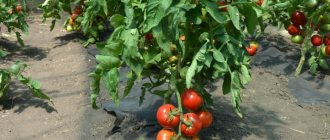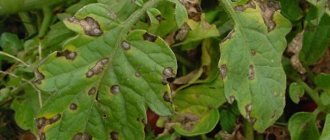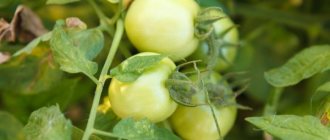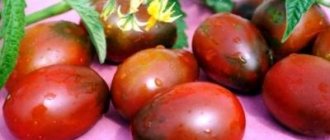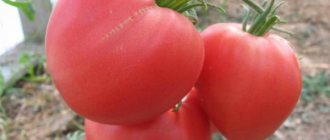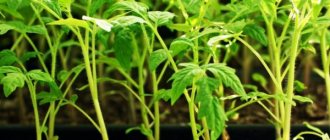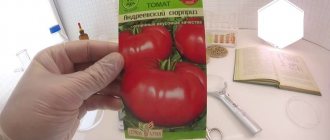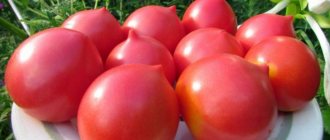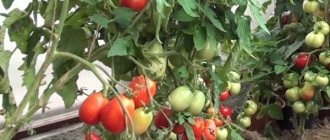When choosing seeds for sowing, every gardener worries about whether the tomatoes will behave in the garden as described. It is on every packet of seeds. But not everything is reflected there. Experienced sellers know much more about tomato varieties.
The above scene perfectly characterizes the Nikola tomato variety. It was at the city market. A woman approached the counter and began meticulously choosing tomato seeds. The seller offered her both, but nothing suited her. In the end, he said: “Plant Nikola, a reliable, proven variety.” The woman replied: “I planted it, I didn’t like it.” The seller was amazed: “Well, if you don’t like Nikola, then I have nothing more to offer.” This short dialogue is evidence of the excellent reputation of the variety among sellers, and they are well versed in this.
Gardeners also agree with them. Reviews from those who planted Nikola tomatoes confirm this. Over the 25 years that have passed since the Nikola tomato was included in the State Register of Breeding Achievements, many new varieties have been created, but it does not lose its position and is invariably in demand among gardeners. Let's make a detailed description and description of the Nikola tomato variety and look at its photo.
Description and characteristics of the variety
The Nikola tomato was created by Altai breeders from the Sedek company in the early 90s and entered into the State Register in 1993. It belongs to the determinants, it stops growing when it reaches 40-60 cm. The bush is spreading, branched, densely leafy, the leaves are bright green, of the usual type. The inflorescence is intermediate, the first raceme with flowers appears above the 8-9 leaf, then new ones develop at intervals of 1-2 leaves.
In terms of ripening time, the variety is mid-early, the first harvest appears 94-115 days after seed germination. Characteristics and description of the fruits: average, 70-100 grams each, but can reach 200 grams. They are round in shape and bright red in color. They ripen almost simultaneously. The fruit has 4-6 seed chambers. The pulp is fleshy and has a pronounced sourness.
Dry matter content – from 4.6 to 4.8%.
Tomatoes are used for fresh consumption, canning and pickling, adding to vegetable stews, slices and other dishes, as well as processing into juices and other tomato products.
How to care
The Nikola tomato variety needs to be grown through seedlings. Manufacturers advise doing this in March. For cultivation in the southern regions, tomato seeds are sown at the beginning of the month, for cool regions - closer to the end. Typically, seedlings are planted in open ground with 7 or 8 true leaves and an emerging flower cluster. With good care, it happens after 45 or 50 days.
Preparing the seedlings
Nikola tomato seeds can be collected from your own garden or purchased at a seed store.
Advice! Once every few years, for varietal purity, you need to buy seeds from a trusted seed company.
In hot weather, tomatoes of different varieties growing nearby are cross-pollinated. If you take seeds from such fruits, you will not be able to preserve the Nikola variety.
Both purchased and own Nikola tomato seeds require pre-sowing treatment. The health of future tomato bushes largely depends on its correct implementation. How and with what to treat the seeds?
- For dressing, i.e., getting rid of possible pathogens located on the surface of the seeds, you can use a solution of potassium permanganate of 1% concentration. Selected Nikola tomato seeds are kept in it for about 20 minutes. Treated seeds must be washed with running water.
- For these purposes, you can also use a 3% concentration of hydrogen peroxide solution. It is heated to 40 degrees and the seeds are treated for 8 minutes. Be sure to wash them after processing.
- Treatment with a phytosporin solution prepared according to the instructions also gives a good result.
- Treated seeds are soaked in a growth stimulator. You can take the following drugs: Humate with microelements, Epin, Zircon. The soaking time and dilution method are indicated in the instructions.
Advice! Experienced gardeners use the old fashioned method: dilute ½ teaspoon of honey in 50 ml of water and use the honey solution to soak the seeds for 24 hours. The vegetables are sweeter and the plants are healthier. The solution should not completely cover the seeds.
You can germinate treated Nikola tomato seeds before sowing, but if you are confident in their good germination, you can sow them immediately. The soil for seedlings should be loose, absorb moisture well and allow air to pass through. Sow to a depth of about 2 cm in such a way that when picking, which is carried out in the phase of 2 true leaves, the roots of small tomatoes are not damaged. Before germination, tomatoes need greenhouse conditions. They are easy to create by placing a plastic bag over the container with the crops. You need to keep it in a warm place.
As soon as the first shoots appear, the container is placed on the lightest windowsill; the temperature at this time should be slightly below normal - about 16 degrees, and at night - about 14. But the maximum amount of light is needed. If the weather is cloudy, additional lighting with phytolamps will be required.
In a week, Nikola tomato seedlings will grow a root system. If they do not stretch out and remain strong and stocky, it means that the seedlings are being raised correctly. In order for her to grow well and in the future she will need:
- temperature is about 22 degrees during the day and a couple of degrees lower at night;
- sufficient amount of light;
- timely watering with warm, settled water as soon as the top layer of soil dries. Some gardeners allow seedlings to wilt by not watering them on time. This stress causes stunted growth and is harmful to tomatoes;
- timely picking into separate containers;
- twice fertilizing with a weak solution of mineral fertilizer: a week after picking and another 2 or 3 weeks later;
- hardening of Nikola tomato seedlings 2 weeks before planting in the ground.
Nikola tomato seedlings are planted only in warm soil. You need to wait until the end of spring frosts so that the planted plants do not freeze. Tomato Nikola is a cold-resistant variety, but the plants are powerless against frost.
Attention! When planting seedlings, you need to provide shelter from possible cold snaps: film or dense non-woven material draped over the arches.
Care after disembarkation
The soil for planting must be prepared and fertilized in the fall. In the spring, they just loosen the soil and apply starter fertilizer to the dug holes. You need to water the holes with plenty of water - at least 1 liter. If instead of water you use a solution of Fitosporin enriched with Gumi fertility elixir, the benefit will be double: Fitosporin will destroy the causative agents of many tomato diseases living in the top layer of soil, and Gumi will promote the rapid growth of the root system, which is important for plant development.
Further care for Nikola tomatoes is as follows:
- watering, the first time - after a week, then weekly, at the time of fruit filling - 2 times a week;
- mulching the soil with any biological material in a layer of 10 cm;
- fertilizing every decade with complex chlorine-free fertilizer in liquid form;
- treatment with calcium nitrate solution when filling fruits in the first cluster - prevention of blossom end rot;
- preventive treatments against late blight: before flowering with chemical protection agents, with the onset of flowering - with biological preparations and folk methods.
Warning! Develop a schedule for treating Nikola tomatoes against late blight and strictly follow it, otherwise you may completely lose your hard-won crop.
You can watch the video about the features of growing Nikola tomatoes:
What they say
What reviews do gardeners and vegetable growers give about the Nikola variety?
In general, their opinion about tomatoes is only positive; they consider it one of the best varieties for growing in Siberia and the Urals. It tolerates changes in weather well, continues to grow and form fruits even when the night temperature drops, and easily tolerates drought, but in rainy summers the yield is higher in the greenhouse.
Farmers like the taste of the fruit and its smooth ripening, which is especially important if tomatoes are grown in the country and it is not possible to pick them every day. Tomatoes do not require special care; they grow without staking or pinching
Another advantage of the variety is its early ripening; even in a short summer, tomatoes have time to ripen, and make it possible to forget that Siberia is a country of evergreen tomatoes.
Pest and disease control
To reduce possible harm, as well as for preventive purposes, it is necessary to treat planting material before sowing in manganese or a 3% solution of hydrogen peroxide. To combat common diseases of adult bushes, Nikola resort to the following treatment methods:
- for blossom end rot - spray with a solution of calcium nitrate (1 tbsp per bucket of water);
- against black spot and powdery mildew - treat the bushes with Bordeaux mixture;
If the infection is not dealt with, the affected plant may die
- against late blight - spraying with garlic infusion (1 tbsp per bucket of water) or fungicidal preparations.
In pest control, agricultural companies use various biological additives, which contain microorganisms that are harmless to tomatoes and humans. However, they are destructive to slugs (for example, parasitic nematodes).
Reviews from gardeners
According to gardeners, the Nikola tomato in most cases lives up to expectations. The fruits ripen early and uniformly, look beautiful - even, neat, of the same size. The taste is also found to be satisfactory (for an early variety). Everyone is especially pleased with the versatility of using the fruits: they can be used for any dishes and preparations.
Everyone who planted this variety considers it easy to care for, but it requires careful disease prevention. It has been noted that in a greenhouse the bushes can reach a much greater height, and then the stems have to be tied up.
According to gardeners, self-collected seeds do not always guarantee the same result next year: in several cases, the characteristics of the variety were not preserved.
Growing rules
Seeds for seedlings are usually planted in the last days of March or the first ten days of April. The exact timing depends on the place of cultivation - in regions with a warm climate, sowing is done earlier, at the end of March. In the north of the country, tomatoes are sown in early April, when the soil warms up.
Since the variety is not a hybrid, seeds for cultivation can either be purchased in a store or prepared independently.
Planting seedlings
Regardless of the origin of the planting material, before planting in the ground it must be treated against typical tomato diseases. For this you can use:
- weak solution of potassium permanganate (processing time - 15-20 minutes);
- hydrogen peroxide solution (concentration – 3%, treatment time – 5-8 minutes);
- Fitosporin solution (processing is carried out according to the instructions).
For better development of seedlings, it is also recommended to soak Nikola tomato seeds in any growth stimulant. In particular, the drug “Zircon” has proven itself well.
Instead of etching with industrial means, you can use a traditional processing method:
- 50 ml of water is diluted with ½ tsp. honey
- The resulting solution is poured into a shallow container.
- Planting material is immersed in sweet water for a day.
- After the specified time, the seeds are taken out and dried thoroughly. After this they are ready for sowing.
Treated planting material can be planted directly in open ground, but only if it was purchased from a reliable supplier and has good germination. When collecting seeds yourself, it is recommended to germinate them before planting them in a permanent place.
The soil for seedlings should have good water and air permeability and be quite loose. When sowing, the seeds are not buried too deep - the depth of the holes should not exceed 2 cm, otherwise the planting material may not sprout. For seedlings to germinate, it is necessary to provide it with greenhouse conditions - for this, the container with the seeds is covered with glass or plastic film. Then the seedlings are moved to a warm place, protected from direct sunlight.
Recommended room temperature is +20-22°C during the day and +18°C at night. As soon as the first shoots appear, the container is moved to the windowsill. If there is a lack of light, it is necessary to organize artificial lighting.
For optimal development of seedlings it is necessary:
- Regularly water the seedlings with settled water at room temperature. The top layer of soil should not dry out - otherwise the seedlings may wither.
- Pick up plants after the first 2-3 leaves appear.
- Feed the seedlings with mineral fertilizers. Before planting in a permanent place, this is done 2 times: a week after planting in separate containers and another 2 weeks after the first feeding.
- Harden tomatoes 1-2 weeks before planting in open ground or a greenhouse. To do this, the seedlings are taken outside for several hours, gradually increasing the time the container is in the open air. This is done so that the plants get used to new climatic conditions.
Transfer
Before planting tomatoes in a permanent place, you must carefully prepare the area. Preparation begins in the fall - for this, the place chosen for the beds is dug up and organic fertilizers are added to the soil. In the spring, the area is loosened again and the prepared holes are filled with water.
Tomatoes are transplanted when 6-8 true leaves appear. In addition, an inflorescence rudiment should form on the seedling. As a rule, this occurs 40-50 days after sowing the seeds.
Nikola tomatoes are planted in open ground in warm weather. The soil must warm up, otherwise the plants may freeze. The variety is frost-resistant, however, young seedlings are vulnerable to the last spring frosts.
Tomatoes are planted at a distance of 50 cm from each other. The row spacing should be at least 60 cm. It is not recommended to thicken the plantings, since Nikola variety bushes do not form, and overgrown plants will interfere with each other.
Aftercare
Caring for Nikola tomatoes is easy. Subsequent care for them is as follows:
- The bushes are watered once a week, being careful not to flood the plantings. During the period of fruit ripening, the frequency of watering is increased to 2 times a week.
- The beds are mulched with sawdust or dry grass for better moisture retention.
- Every 8-10 days, plantings are fed with complex liquid fertilizers. For the first feedings, a solution of mullein or bird droppings is suitable. Then organic fertilizers are replaced with mineral ones: potassium or phosphorus.
You can learn more about the features of growing Nikola tomatoes from the video below:
Planting and care
Planting and subsequent care of Nikola tomatoes does not require much experience in growing vegetables. It is grown by seedling method. Seeds are sown in the first half of March for subsequent cultivation in greenhouses. And at the end of the first spring month, if you plan to grow the crop in vegetable soil.
Attention!
The Nikola tomato is a cultivar. You can harvest its seeds yourself. But before sowing, they must be disinfected in a solution of potassium permanganate or phytosporin.
Sow seeds in containers filled with moistened soil. The top is mulched with a layer of peat or soil. They are thoroughly moistened and covered with glass or film and left to germinate. Containers with emerging shoots are transferred to a well-lit place. Water, feed with complex fertilizers for seedlings, and gradually harden off. At the 2-4 leaf stage, seedlings are transplanted into separate cups.
Seedlings are planted in the ground after stable positive night temperatures have established and the soil has warmed up well. Usually this is the end of May or the beginning of July. Seedlings can be planted in greenhouses as early as the second ten days of May.
History of the variety's creation
Breeders from the Siberian and Ural regions have been working for decades to develop new varieties and hybrids of tomatoes that could be grown in the conditions of these cold regions of our country. In Altai, breeders developed the “Siberian early ripening” variety, which was repeatedly improved, adapting this vegetable crop to the changeable weather conditions of the region, improving productivity and early ripening.
Tomato Nikola, a variety bred on the basis of “Siberian early ripening”, is a new variety of tomatoes with improved characteristics and taste. This tomato is not a hybrid. After testing, the Nikola variety was included in the State Register at the end of the last century.
Tomato Nikola
This tomato was zoned for cultivation in the Middle Volga region and Western Siberia for planting in open and closed ground. Nikola tomatoes are highly resistant to stress and do not reduce the growth and ripening of fruits even in unfavorable weather conditions.
Important! This variety was also tested in the Volga-Vyatka and East Siberian regions, where it showed high technical characteristics and good yield.
Harvesting
But this needs to be done together with the stalks or even the brushes; it is in this form that the tomatoes will be able to ripen faster and better in a warm and dark place.
The variety can be stored for quite a long time, for this it is necessary to observe the temperature regime and maintain the required level of humidity in the room. It will be ideal if the thermometer shows +17 and the humidity is no more than 40%.
The Nikola tomato is quite easy to care for; its excellent taste and marketability characteristics allow it to be grown both by single gardeners and on an industrial scale.
Tomatoes belong to the nightshade family and love hot, dry climates. The variety often has a huge influence on the yield.
Different tomatoes behave differently in different conditions and this changes their quality characteristics.
Varieties are determinate and indeterminate.
Indeterminate ones can reach two meters and if they are not pinched in time, they can be even larger. But, you need to understand that the roots will not be able to feed the plant in this case, and the owner will not like the result.
The second, are not tall, flower brushes have a bookmark after 9, 8 leaves, and the subsequent ones are formed after 2 - 3, 5-6 the brush ends the plants. And one of these varieties is the Nikola tomato.
The history of the appearance of tomatoes in Europe
Previously, the fruits were considered poisonous
The tomato was first described by the Italian scientist - botanist P. Mattioli. This happened in the middle of the 16th century, when, after Columbus, European sailors began to explore South America.
Despite the fact that the Mexican Indian tribes called tomatoes golden apples and grew them since ancient times, in Europe for a long time the fruits of this plant were considered not only inedible, but even highly poisonous.
In Europe and Russia, they stubbornly decorated flower beds with tomato bushes and did not want to eat them. In Holland they were grown in pots as indoor flowers. The Portuguese and Italians were the first to massively use tomatoes in cooking, and the warm, mild climate of these countries contributed to their cultivation in open ground.
In Russia, tomatoes began to be cultivated not for beauty, but for food, thanks to the efforts of the Russian scientist Andrei Bolotov.
In Crimea, at the end of the 19th century, the cultivation of tomatoes became widespread. Gradually, culture began to move north. This happened quite slowly, because the temperatures usual for most regions are destructive for heat-loving tomatoes, and if it is not warmer than + 10 outside, they stop growing and developing.
By the mid-twentieth century, varieties and hybrids were obtained not only for the south and central Russia, but also for the Urals and Siberia. Currently, almost 500 varieties are recommended for cultivation in open ground.
Today there are a huge number of tomato varieties.
It is important to remember that modern varieties of tomatoes differ not only in appearance and taste, but primarily in ripening time:
- very early
- average
- late
In order for tomatoes to be fresh on the table and to be able to prepare them for the winter, it is necessary to plant varieties with different ripening periods on the plot.
And it’s not at all difficult to grow it
To grow tomatoes of the Nikola variety, you do not need to master new technologies; everything happens according to the usual scenario - seedlings, diving, planting in a permanent place. When to sow seeds for seedlings depends on the timing of the arrival of real spring with warmth from +17-18 degrees at night, and up to +25 degrees during the day, so that the seedlings can be planted in the garden. This could be mid-February, or the beginning or end of March.
Before sowing, seeds are treated with a weak solution of potassium permanganate to make them more resistant to fungal and bacterial diseases.
Tomatoes take root and bear fruit better if they are picked; the picking is carried out at the stage of the appearance of two or three pairs of true leaves. The leaves of the seedlings of this plant always grow in pairs. This happens in the second or third week after emergence.
You can plant them under a film in the garden, or in separate pots, and then plant them together with the soil in a permanent place. Planting is carried out according to a typical 50x70 cm pattern.
The soil must be warm enough, loose, fertile - fertilizers are applied in advance, when digging.
7-10 days after moving to a permanent place, the tomatoes are earthed up, this is done to form additional roots that will absorb even more moisture and nutrients. The second hilling is carried out after another 1-2 weeks, while a smaller mound is poured; in fact, this procedure is combined with loosening the earth.
Watering is often carried out only before the fruits appear, when they begin to ripen, they do not need excess water - the fruits will crack or begin to rot. In warm regions, tomatoes are watered directly from a hose, but in Siberia and the Urals, where the air temperature at night can drop below +20 degrees, it is better to water them with water that has been previously collected in barrels and warmed in the sun.
When planting seedlings on pre-fertilized soil, you do not need to feed the tomatoes, but you can spray the leaves several times. During flowering, the bushes are treated with a solution made from a bucket of hot water and 1 teaspoon of boric acid. The solution is used after cooling. Urea is not used for foliar feeding at this time, as this has a bad effect on the development of the ovary.
A superphosphate solution in the same dosage will promote the appearance of a large number of ovaries.
To increase productivity, an infusion of young nettles is used, it is collected, crushed, filled with water, and after a day, used for its intended purpose, after filtering through cheesecloth. When fruits are forming, tomatoes are sprayed with a solution of manganese and laundry soap.
You can also use ready-made preparations, for example – Ovary, which contains several trace elements.
Characteristics of tomato Nikola
The Nikola variety is adapted for cultivation in central Russia, as well as in the Northern regions of the country. It safely tolerates hot summers with little precipitation, fairly harsh winters and sudden temperature changes. Nikola tomatoes can be grown both in greenhouse conditions and in open ground.
Productivity and fruiting
The variety is classified as mid-season - tomatoes fully ripen in an average of 120 days. In addition, this variety is characterized by consistently high yields, which makes it possible to grow tomatoes on an industrial scale. According to the description of the Nikola tomato variety, from one bush you can harvest from 3 to 5 kg of fruit, which is confirmed by reviews from gardeners. Tomatoes ripen almost simultaneously.
Area of application of fruits
The variety was bred primarily for sale on an industrial scale - Nikola tomatoes tolerate long-term transportation well and retain an attractive appearance for a long time.
Tomatoes are also used for preparing salads and preparations. Due to their small size, they are often used for whole-fruit canning. Due to their high dry matter content, tomatoes can be used as a base for tomato pastes.
Resistance to diseases and pests
From the reviews of gardeners it follows that the Nikola tomato variety has average resistance to typical tomato diseases. For example, it is vulnerable to:
- late blight;
- crown rot;
- macrosporiosis;
- black spot;
- powdery mildew;
- septoria.
Pests rarely attack the variety.
Advantages and disadvantages of the variety
The advantages of Nikola tomatoes include the following characteristics:
- consistently high productivity;
- no need for stepsoning;
- high frost resistance;
- simultaneous ripening of fruits;
- good transportability;
- long shelf life;
- undemanding to the composition of the soil;
- resistance to temperature changes.
The main disadvantage of the variety is its low resistance to most tomato diseases, however, with proper care, the bushes practically do not get sick.
Description of Nikola tomatoes
The Nikola tomato is not a hybrid form, so you can collect the seeds for planting yourself - tomatoes grown from them do not lose their varietal qualities, as is often the case with hybrids.
Nikola is a determinate group variety. Tomato bushes are medium branched, with a moderate amount of foliage. Plants reach about 60-65 cm in height when grown in open ground and 70-75 cm in a greenhouse. The leaf blade of tomatoes is small and smooth. The surface of the leaves is light green.
The first inflorescences of the variety are formed under the 7-8 leaves. Subsequently, they form from 5 to 7 fruits.
Description of fruits
The description of tomatoes of the Nikola variety indicates that the shape of the fruit is standard, round, without pronounced irregularities, as can be seen in the photo below. Their weight varies on average from 95 to 120 g. Greenhouse-grown tomatoes are slightly larger - they can grow up to 150 g.
Ripe Nikola tomatoes are colored rich red. They taste sweet, with barely noticeable sourness. The fruits are fleshy and juicy.
Advantages and disadvantages
Beautifully shaped fruits
The positive characteristics of the Nikola variety include:
- early ripening;
- excellent yield (4-7 kg);
- beautiful, even fruits;
- good taste;
- universal purpose;
- resistance to cold and weather changes;
- excellent keeping quality and transportability;
- easy care.
Among the disadvantages are:
- susceptibility to late blight, blossom end rot, powdery mildew;
- When collecting seeds yourself, the varietal characteristics of the tomato are not always preserved.
Resistance to diseases and adverse conditions
The bushes can easily withstand low temperatures.
This is not typical for varieties of Siberian selection, but the variety is not immune to late blight. To prevent late blight, the bushes are sprayed with a solution of Fitosporin, a concentrate is made from 50 g of the drug and 100 ml of water, then 1.5 tbsp. spoons of the concentrated solution are poured into a bucket of water (10 l) and sprayed on the tomatoes.
Bushes can also suffer from dry, white and black bacterial spots, and blossom end rot.
